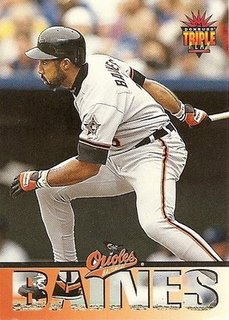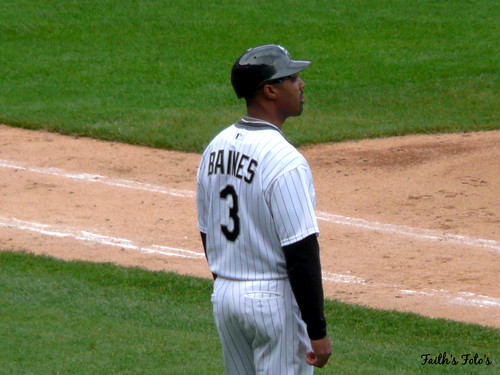The Yankees have long been the favorite targets of rival fans, rival team owners and media pundits for a very long time. In the early 1970's we were told that free agency would ruin baseball, mostly because it was thought that nobody could afford to pay players what they were actually worth, essentially. Even George Steinbrenner himself said,
"I am dead set against free agency. It can ruin baseball."
As it turned out, though, teams like the Yankees could afford to pay the going price for (presumably) the best available players, while other teams sometimes had to struggle to get by. Free agency was the best thing to happen to the Yankees since Mickey Mantle. King George was smart enough to realize this, so afterwards he kept quiet about the issue, while others lambasted him for spending so much money on free agents like Catfish Hunter, Goose Gossage, Reggie Jackson, Dave Winfield, and Rickey Henderson, among others.
Not that it worked. I mean sure, the Yankees used free agency to supplement a pretty decent team in the late 1970's and they won two World Series for their efforts, but then they went 18 years before they won another one, and went 14 years without even making the playoffs, despite the perennially high payrolls.
Efforts to sign big-name, superstar free agents were often unsuccessful and sometimes disastrous. Ed Whitson, Jack Clark, Terry Mulholland, Kenny Rogers and Danny Tartabull come to mind, among others. Even if they performed, it wasn't up to par with the fans' and writers' expectations, and so they were quickly dispatched to the far reaches of the major leagues, usually for pennies on the dollar.
When they did start winning World Series, they did so with teams predominantly composed of home-grown players (Jeter, Pettitte, Mariano Rivera, Jorge Posada, Bernie Williams, Ramiro Mendoza) and the products of shrewd trades (John Wetteland, David Cone, Paul O'Neill, Tino Martinez, Jeff Nelson, Tim Raines, Scott Brosius, Roger Clemens, David Justice). Granted, many of those trades (like the ones for Clemens and Chuck Knoblauch) only happened because the Yankees could most easily afford to meet their salary demands, but still, the Yankees were shrewd to make them.
Not that free agents played no role, but when they did, those players were often complementary (Darryl Strawberry, Orlando Hernandez) rather than stars. For what it's worth, in their four most recent championship seasons, any Yankee MVP or Cy Young votes usually went to either home-grown players or those acquired in trade. Only David Wells, a journeyman southpaw who who had signed as a free agent before the 1998 season, bucked this trend by getting a smattering of votes for each in that year, and the Yankees were as surprised as anyone when he briefly blossomed into a star.
But this new crop of free agents is expected to carry the team.
The recent signings of Mark Teixeira (8 years, $180 million), CC Sabathia (7 years, $161 million) and A.J. Burnett (5 years, $82.5 million) has spurred a lot of bitterness in the baseball writing community, at least amonth those who are not Yankee fans. Phil Sheridan of the Philadelphia Inquirer says that the Yankees' free spending ways, in the midst of poor economy, is
"...the most egregious display of financial irresponsibility in the history of sports."
Which is ridiculous. That title obviously belongs to the $55 million contract the Dodgers gave to Darren Dreifort. Or perhaps the $65 million Chan Ho Park got from the Rangers. No, wait, Russ Ortiz. Or maybe Barry Zito or Mike Hampton. Or whatever we spend to train the Olympic curling team. At least Burnett, Sabathia and Teixeira are actually good players, and stand a decent chance of continuing to be good for a few years.
The San Francisco Examiner's Bob Franz thought the Yankees were ruining baseball, and that was before they signed Teixeira. He too cites the lousy economy, as well as the fact that the Yankees' new ballpark is partially being paid for by taxpayer money. (Well, the infrastructure improvements are, anyway, but let's not be too picky.)
Bill Bradley of the Sacramento Bee thinks these signings show the sport's need for a salary cap, and Brewers' GM Mark Attanasio agrees. This notion comes out every time something like this happens, and there's never been any real progress on the matter. Nor will there be, if the MLB players' union remains as strong as it has been for the last three decades.
Phil Rogers points out that the Yankees have spent about $130 million more on their free agents this winter than the other 29 teams have spent combined, which is interesting. Still, though, it's not as staggering as he would have you believe, since there was nobody anywhere near as good as the Yankees' three signees to whom the other 29 teams might pay that kind of cash. Rogers also correctly notes that if nothing else, these free agent signings make 2009 an all-or-nothing year for the Yankees, and especially field manager Joe Girardi.
Todd Jones of the Sporting News suggests that the Yankees can't buy themselves a championship, and though he mixes metaphors inappropriately and mis-quotes some stats (Burnett won 18 games last year, not 17), his point is taken.
The problem with most of these arguments is that they confuse the lagging economy and government bailouts of big businesses with what the Yankees spend and how they decide to spend it. While baseball may not be "recession proof", the Yankees still find themselves with a lot of advantges going into 2009:
- They're still the most recognizable brand in sports
- They still play in the largest market in the country
- They still have their own cable TV network
- They have a brand new sadium opening this spring
- They won 89 games in 2008, enough to have won two of the six divisions in baseball
- and they had about $70 million coming off the annual payroll.
They're not asking Uncle Sam to foot the bill for Sabathia and Teixeira and Burnett and A-Rod and Jeter. They're not laying people off like Ford and GM, and then turning around and asking for more money for themselves. They're not using taxpayer dollars to offset the expenses of golden parachutes offered to their departing executives. They've managed their own business well, and can spend the profits however they please.
The Yankees have their own money. They're not asking for handouts. They're selling a product, and their fans don't show any signs of reluctance to buy it. They've made lots of money in the past and they expect to continue that trend. And if the failing economy starts to hurt them at the gate, they'll be the ones forced to pony up the dough for these big contracts, not us.
And lest you assume that the Yankees will raise ticket and concession prices to recoup their losses, please understand that it doesn't work that way. Basic economics states that the prices are regulated by supply and demand, and in this case the supply is set at 52,325, so it's just demand. If the demand goes down, the price will go down, not up. If attendance starts dropping, they'll be forced to lower ticket prices to make up in volume what the've lost in margin.
One of the few reasonable voices out there, Will Carroll points out that the Yankees really aren't spending money they don't have. They had room in the "budget" with the departures of Jason Giambi, Mike Mussina, Carl Pavano, Bobby Abreu, and (we assume) Andy Pettitte, and they took advantage of that fact.
Even with the 2009 salaries and signing bonuses of these three players, plus another $10 million or so in raises to current players like A-Rod, Robinson Cano, Nick Swisher, Chien-Ming Wang, Xavier Nady and the Melk Man (who failed to deliver), the Bronx Bombers still find themselves about $20 million shy of last year's historically large payroll.
You see, the Yankees keep themselves in check. It's only because they overspend on free agents that they are not even more successful. The pressure of playing in New York requires them to overpay for free agents, and that means that when a signing proves to be a bust, it's that much more spectacular and tragic.
That, in turn, makes them a little more wary next time around, or ties up their payroll in costly albatrosses like Carl Pavano, so that when a Carlos Beltran or Johan Santana hits the market, they can't always snatch him up. Granted, often they can, but just as often they end up eating about half the contract when the player ages prematurely or, as in the case of Jason Giambi, stops taking steroids and gets and intestinal parasite.
Some teams may have to wait and hope for victory. Royals fans may remain delusional on the issue. The Oaklands and Tampas can play Moneyball and the Minnesotas can play little-ball and the Brewers can try to catch lightning in a bottle, but the Yankees were already spending a lot of money on their team, even before the $423.5 million they promised to A.J., C.C. and Mark and if they wanted to have anything to show for it next year, the only way was to spend even more.








